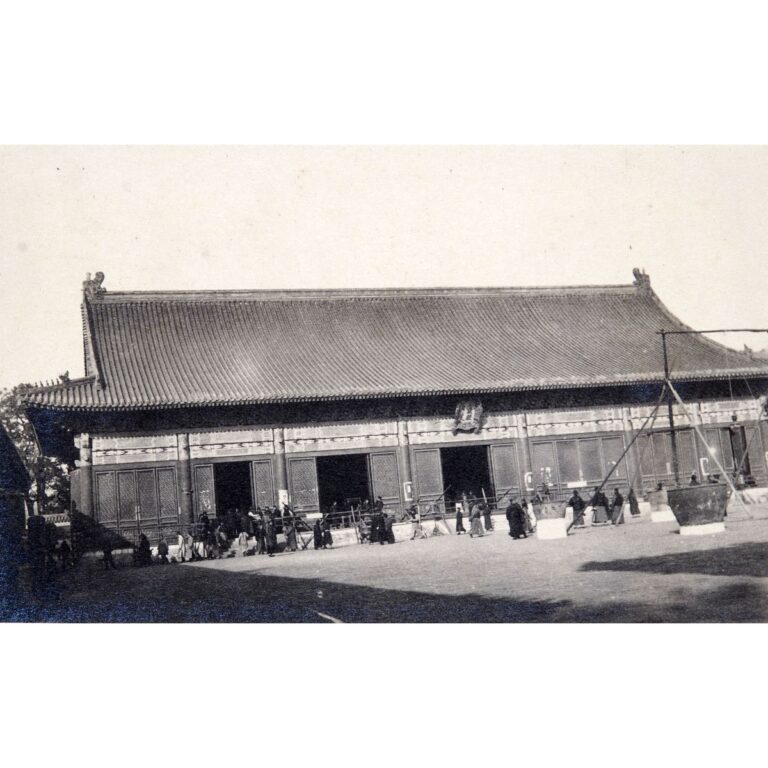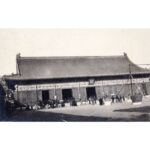Photography Taisui Hall at the Temple of Agriculture
A black-and-white photograph showing the Taisui Hall (Taisuidian 太歲殿), dedicated to the worship of and named after the god Taisui 太歲, literally meaning “Highest Year”. The hall is located in the Temple of Agriculture (Taisuidian 先農壇) complex in Beijing. It was built in 1420 by the Yongle Emperor (reigned 1402–1424). Here the emperors of the Ming and Qing dynasties held annual worship rituals once a year on the day of the spring equinox, to pray for a bountiful harvest.
The hall is built using the traditional Chinese construction technique, the dougong 斗拱 system. In addition to the dowels in the eaves, other features of Chinese construction that can be found in the Taisui Hall are the shapes of the roofs and the use of colours, numbers, and decorative animal figures. The quatrefoil (wudianding 廡殿頂) is decorated with glazed tiles and decorative figures – at the two ends of the main eaves are larger figures, and at the side eaves are smaller ... more
A black-and-white photograph showing the Taisui Hall (Taisuidian 太歲殿), dedicated to the worship of and named after the god Taisui 太歲, literally meaning “Highest Year”. The hall is located in the Temple of Agriculture (Taisuidian 先農壇) complex in Beijing. It was built in 1420 by the Yongle Emperor (reigned 1402–1424). Here the emperors of the Ming and Qing dynasties held annual worship rituals once a year on the day of the spring equinox, to pray for a bountiful harvest.
The hall is built using the traditional Chinese construction technique, the dougong 斗拱 system. In addition to the dowels in the eaves, other features of Chinese construction that can be found in the Taisui Hall are the shapes of the roofs and the use of colours, numbers, and decorative animal figures. The quatrefoil (wudianding 廡殿頂) is decorated with glazed tiles and decorative figures – at the two ends of the main eaves are larger figures, and at the side eaves are smaller figures in a strictly followed sequence. The eaves are decorated with dowels or wooden joints in three levels, with three bands below, patterned yellow, green and blue respectively. Underneath them, the red decor of the rest of the building takes over, with double doors attached to round supporting columns. In addition to the hall, there are three individual buildings and a kiln for burning silk offerings to the god Taisui.
The entire scene around the Taisui Hall is only a small part of the 86-hectare complex of the Temple of Agriculture, which is now located in the southeastern part of Beijing – below the Forbidden City and near the famous Temple of Heaven (Tiantan 天壇). Both complexes have a similar layout, surrounded by double walls and divided into several enclosed arenas. On the day of the vernal equinox, the emperor left his palace in the Forbidden City for the Outer City (Waicheng 外城), approaching the Temple of Agriculture with a procession of court servants and officials. The main ritual was the emperor’s symbolic ploughing of the first furrow in the new sowing season. The last emperor to pay homage to the year here was Emperor Guangxu (reigned 1875–1908). This was the end of a centuries-old tradition. After that, the buildings of the complex were used for military and industrial purposes. Since 1991, the complex has been open to the public as the Beijing Museum of Classical Architecture Beijing Gudai Jianzhu Bowuguan 北京夏令建築博物館.
The photograph is the 185th of 449 photographs of Beijing and its surroundings in the album of Ivan Skušek Jr., purchased during his stay in Beijing (1914–1920). In the handwritten inventory of the album, the photograph is referred to as Ackerbau-Tempel: Kaiser-Halle. (DZ, MV)





































Do you have a comment or additional information about the subject?